After winning four straight Ukrainian Premier League titles from 2017-2020, Shakhtar Donetsk ended the 2020/21 campaign in second-place by eleven points to the eventual winners, Dynamo Kyiv.
Having failed to progress past the Round of 16 of the UEFA Europa League or win a single domestic trophy, Portuguese manager Luis Castro announced that he would leave the club at the end of the campaign.
It did not take the Shakhtar hierarchy to find their managerial replacement and opted to go for a much younger and more vibrant manager in Roberto De Zerbi, the former Sassuolo and Empoli head coach, and an ex-Milan youth player.
Lauded for his high-octane and possession-oriented style of football, De Zerbi’s switch to Ukraine was surprising given his growing reputation in Italian football but has been one of the most interesting managerial appointments in Europe.
With the competitive league already commencing in Ukraine, Shakhtar have won four out of five games under the Italian – including winning both legs of their UEFA Champions League third qualifying round tie against Genk – but his system of play is what has caught most people’s eyes.
This article will be a tactical analysis of Shakhtar Donetsk under De Zerbi in the form of a team scout report. It will be an analysis of the Ukrainian side’s new positional play tactics.
Starting lineup and player profile
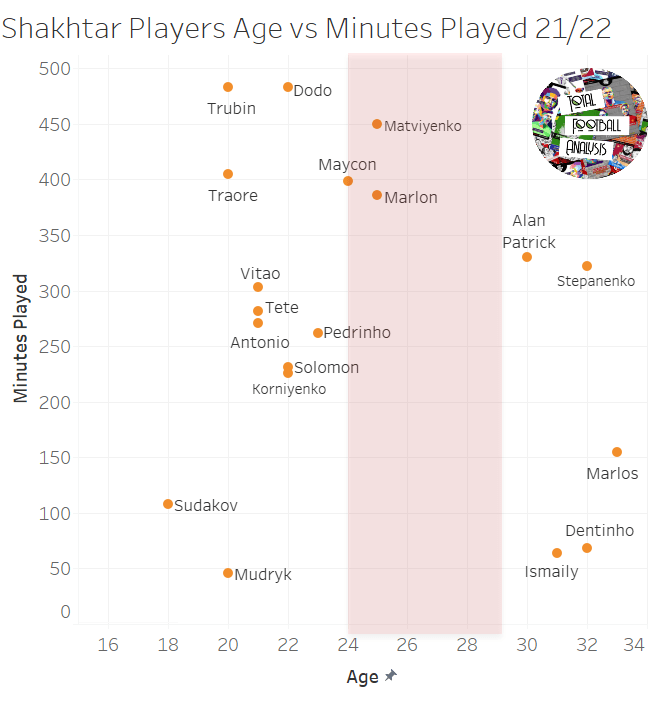
The graph above shows the age profile of players that De Zerbi has been using the most this season. The players who have played the most minutes are mainly under the age of 24 with the exclusion of certain first-teamers such as Marlon Santos, Maycon, Alan Patrick, Mykola Matviyenko, and Tepas Stepanenko.
De Zerbi has put his trust into a very young group of players to carry out his energetic, high-pressing, and dynamic style of play. There are still some players with experience in the squad to help the younger players though too.
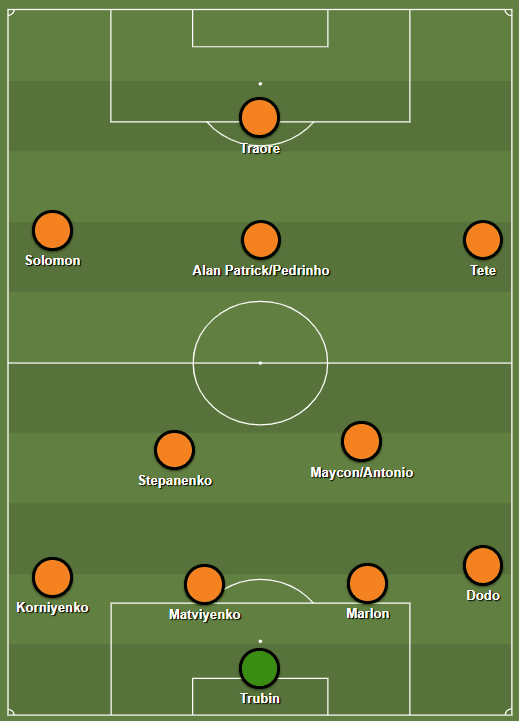
Much like at Sassuolo, De Zerbi’s preferred choice of starting formation is 4-2-3-1 or a slight variation of this in the 4-4-1-1 where the wingers are positioned deeper on the pitch. The image above shows the most used starting eleven so far under the Italian manager using the player profile graph, five competitive games into the season.
This Shakhtar Donetsk team is the third-youngest in the Ukrainian Premier League so far this season with an average of 24.1.
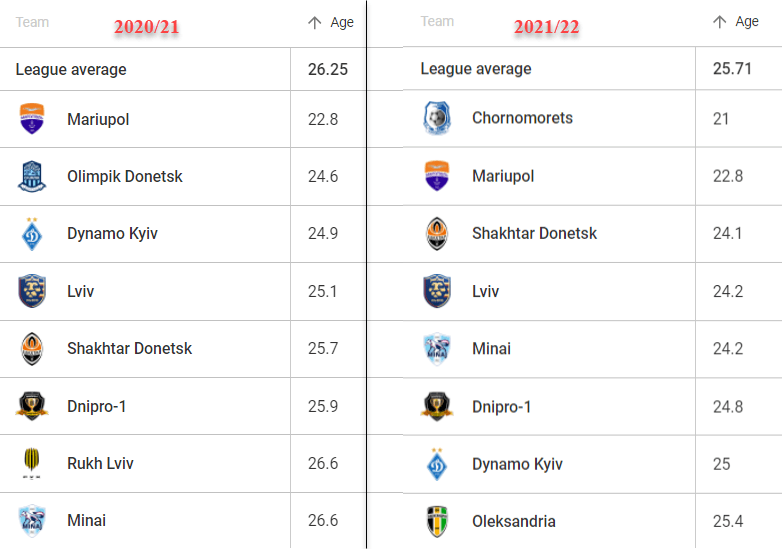
In fact, this is the youngest Shakhtar team on record on Wyscout which dates back to the 2015/16 season. In the 2020/21 campaign under De Zerbi’s predecessor Castro, Shakhtar’s average age of their squad was 25.7 so the Italian manager has drastically reduced the team’s age within just a few months.
Build-up phase
As with all modern possession-oriented sides, such as Barcelona and Manchester City, Shakhtar Donetsk like to build their way through the thirds, playing out from the goalkeeper. As with De Zerbi’s Sassuolo team, the Ukrainians take immense risks when making passes to play through the opponent’s press.
Their set-up allows them to do so. As stated, Shakhtar play with a 4-2-3-1 base formation. The build-up phase is the only phase of the attack where this remains a constant in terms of the player’s positioning on the field.
The two centre-backs stay at the edge of the six-yard box and form a line with the goalkeeper while the two fullbacks push up to slightly more advanced positions.
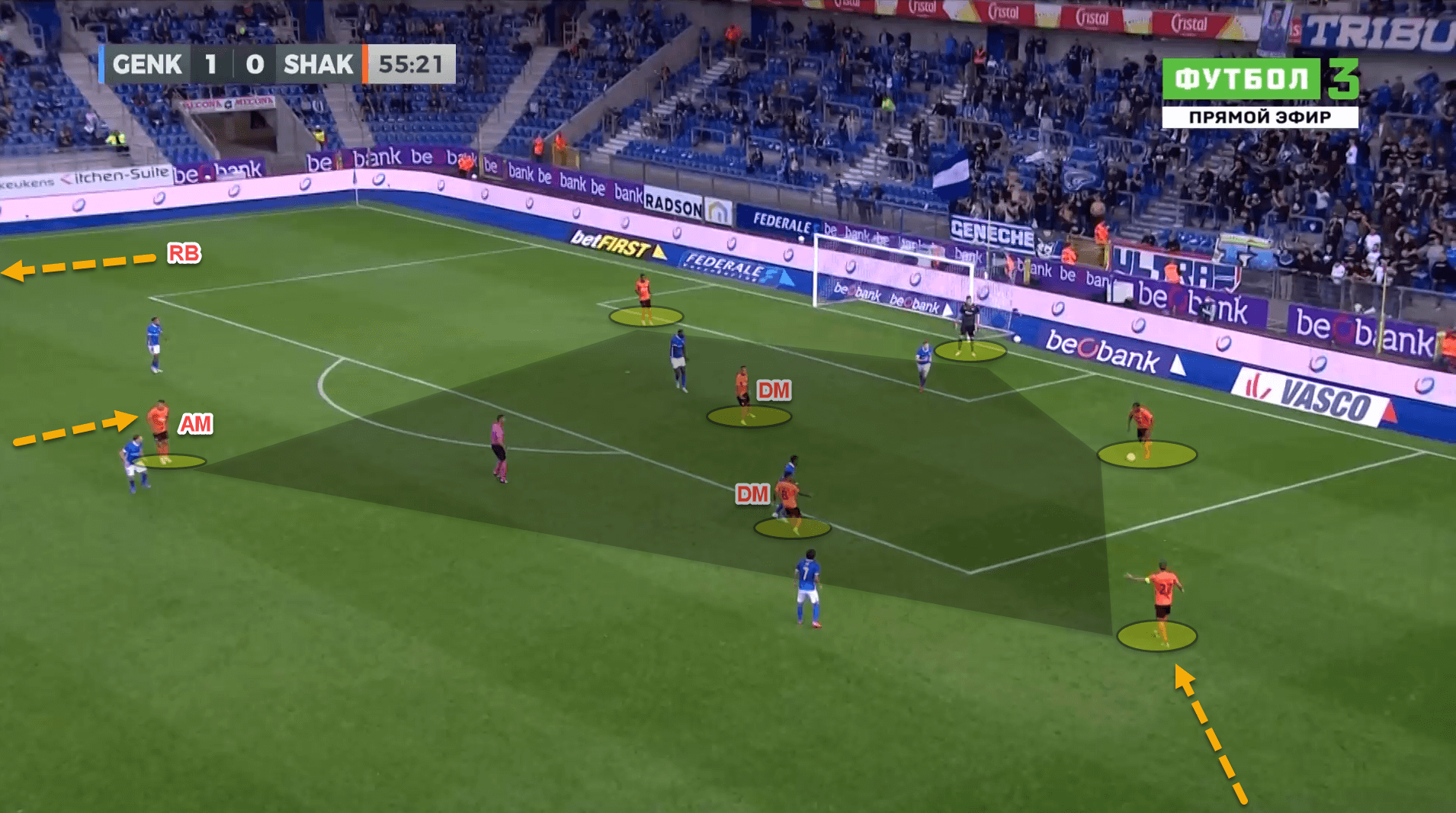
Shakhtar’s double-pivot drop into deep positions on the field, even as low as the 18-yard box, creating passing angles to help the centre-backs and the goalkeeper have options to play out of pressure. These two midfielders do not remain stagnant and are always moving, dragging their man around in an attempt to open up passing lanes behind them.
The attacking midfielder has also dropped very deep to get involved in the build-up play and act as a potential outlet from Genk’s high press.
What is very noticeable from the image above is the distances between each player. In this first phase, De Zerbi orders his back four and three central midfielders to stay very narrow. The fullbacks push inside, close to the double-pivot, while the two defensive midfielders stay adjacent to one another.
Shakhtar’s players have close connections to each other which makes quick and fluid passing out of pressure much easier and more dynamic at a higher tempo.
Further up the pitch, the front three stretch the opponent’s backline vertically and horizontally.
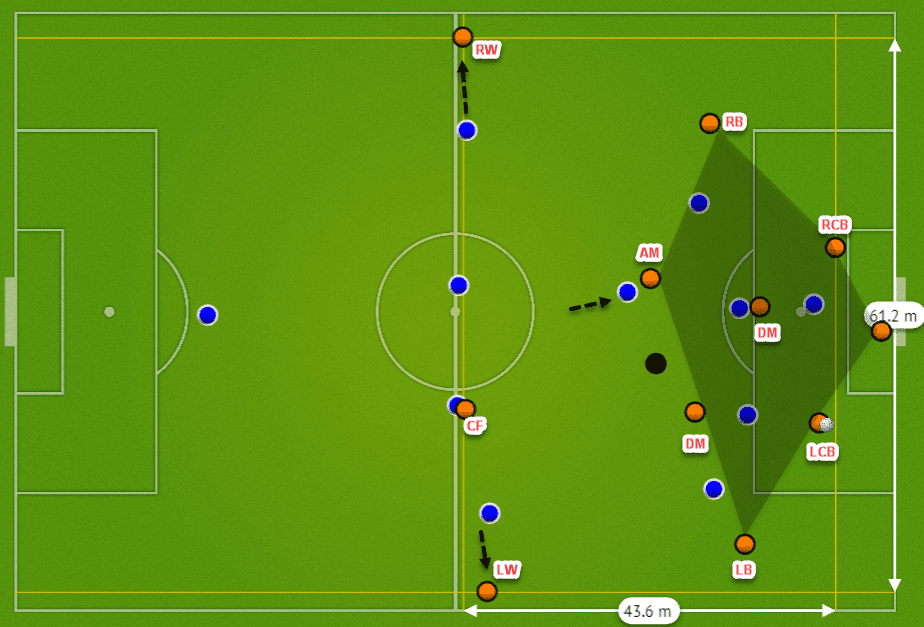
Here is a 2D view of Shakhtar’s set-up in the first phase of their positional attacks. With the wingers stretching horizontally and the midfielders dropping into lower areas of the pitch, the opposition’s high press can be played through, particularly when De Zerbi’s men go direct to the centre-forward.
Having the three central midfield players in deeper positions on the pitch not only aids with playing out from the back as Shakhtar have an 8v6 central overload – as can be seen above – but it also drags their markers with them which leaves space in behind the opponent’s midfield to be exploited with direct passes to the striker.
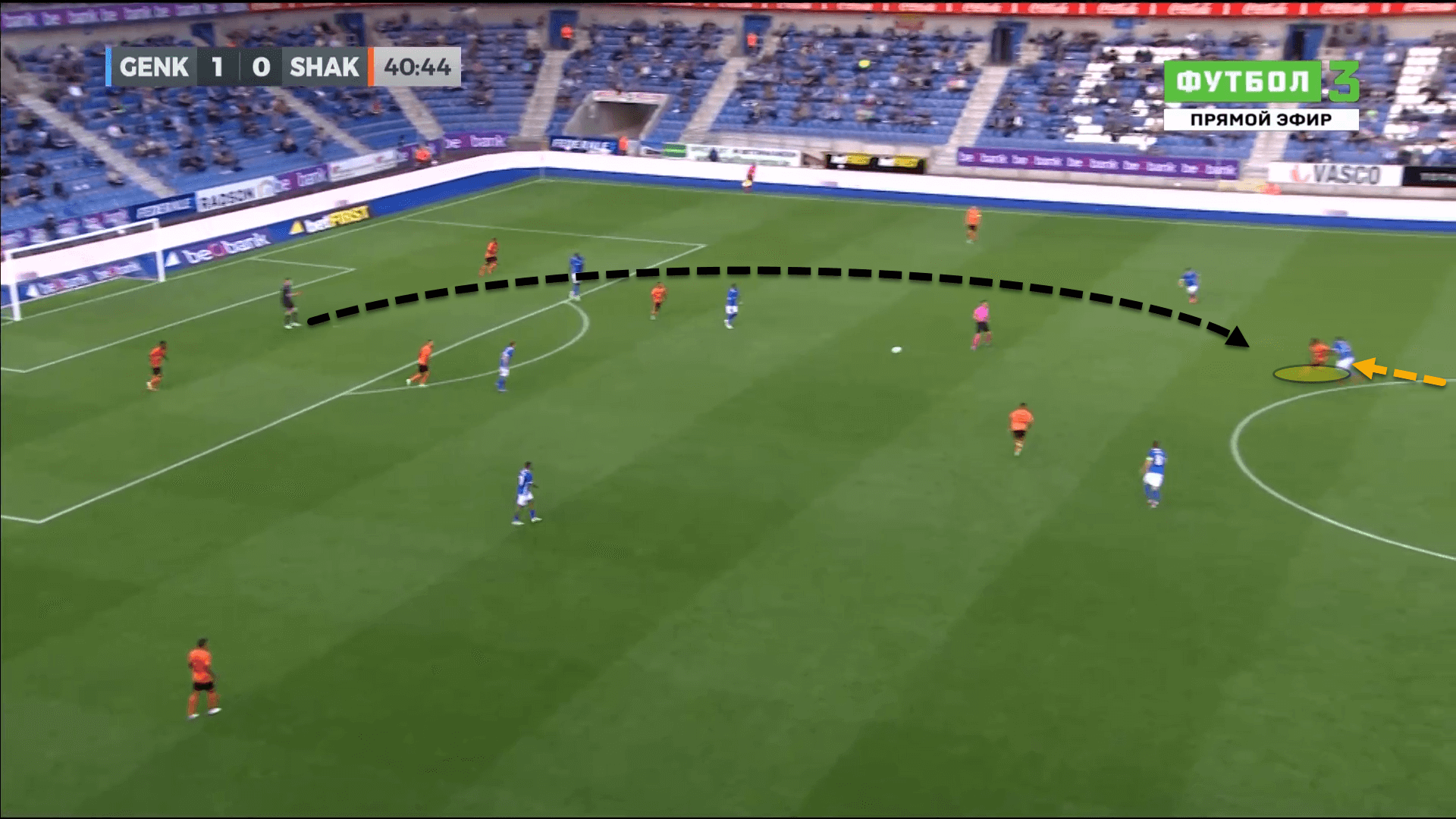
Quick passes with short distances between players, and direct balls to the dropping centre-forward in space are the two ways that De Zerbi’s Shakhtar like to play their way out of the back this season.
Narrow and compact further up the pitch
When Shakhtar Donetsk progress to the middle third of the pitch in a positional attack, more commonly known amongst analysts as the progression phase, the Italian head coach instructs his players to remain compact and narrow.
Narrow possession structures are a given when playing under De Zerbi. They tend to create overloads in the central corridors, including the halfspaces, while positioning just one player in the wide channels on each side.
Being hell-bent on having just two players out wide means that a lot of positional rotations and interchanges take place throughout a match. For instance, if the left-back is high and wide and the ball-near winger decides to occupy this space instead, the fullback must push into the left halfspace so that two players do not occupy the same vertical line in these wide areas.
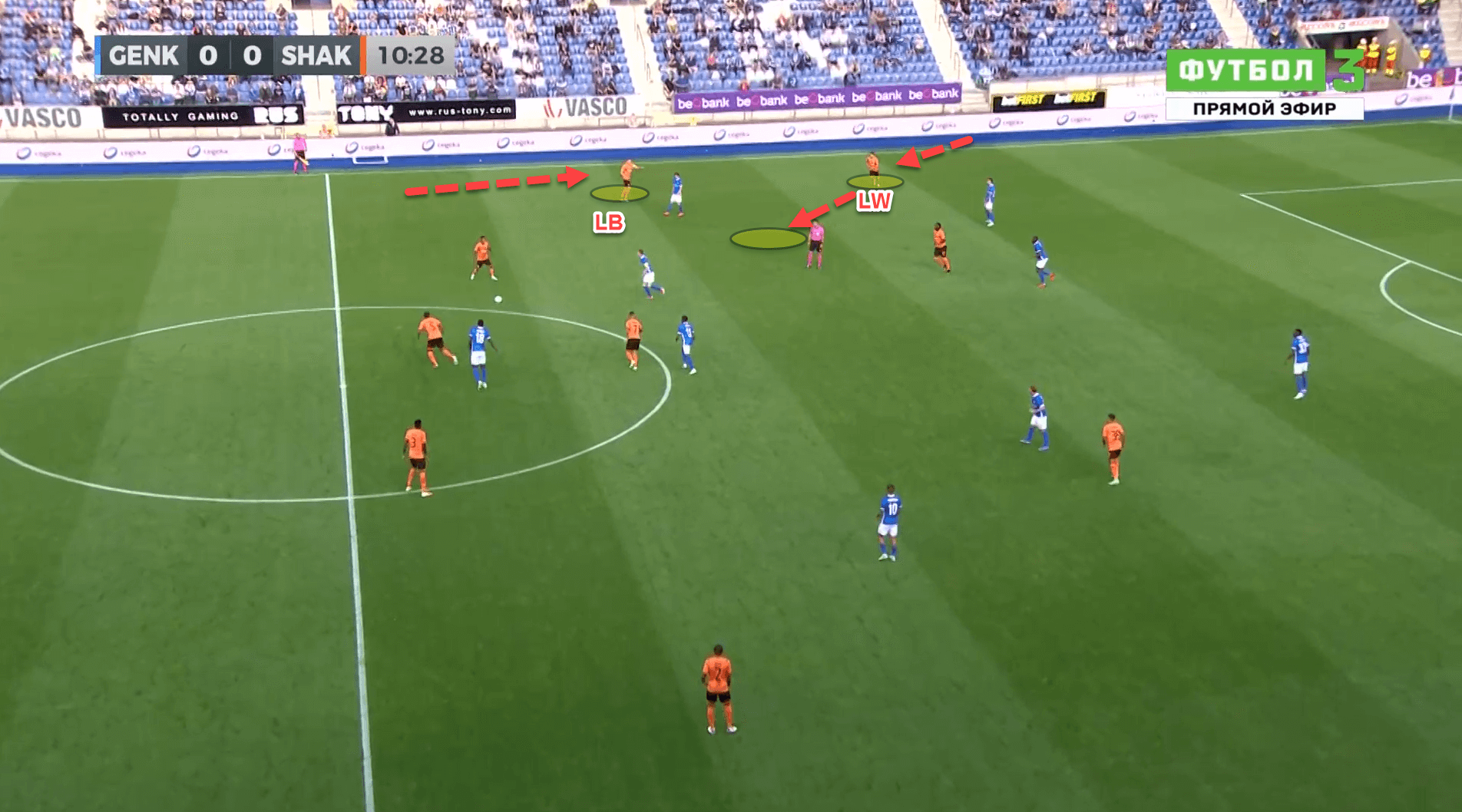
In this instance, the left-winger was positioned out on the left flank and was stretching the opposition in this area. Shakhtar’s left-back, Korniyenko, has advanced further up the pitch and can be seen telling the winger to move inside in order to ensure that the team maintains a good structure in their positional attack.
The rest of the players stay in the central areas and remain very compact, keeping close connections once again to one another. The reason for this is because it forces the opposition’s defensive block narrow too which leaves space out wide to be exploited.
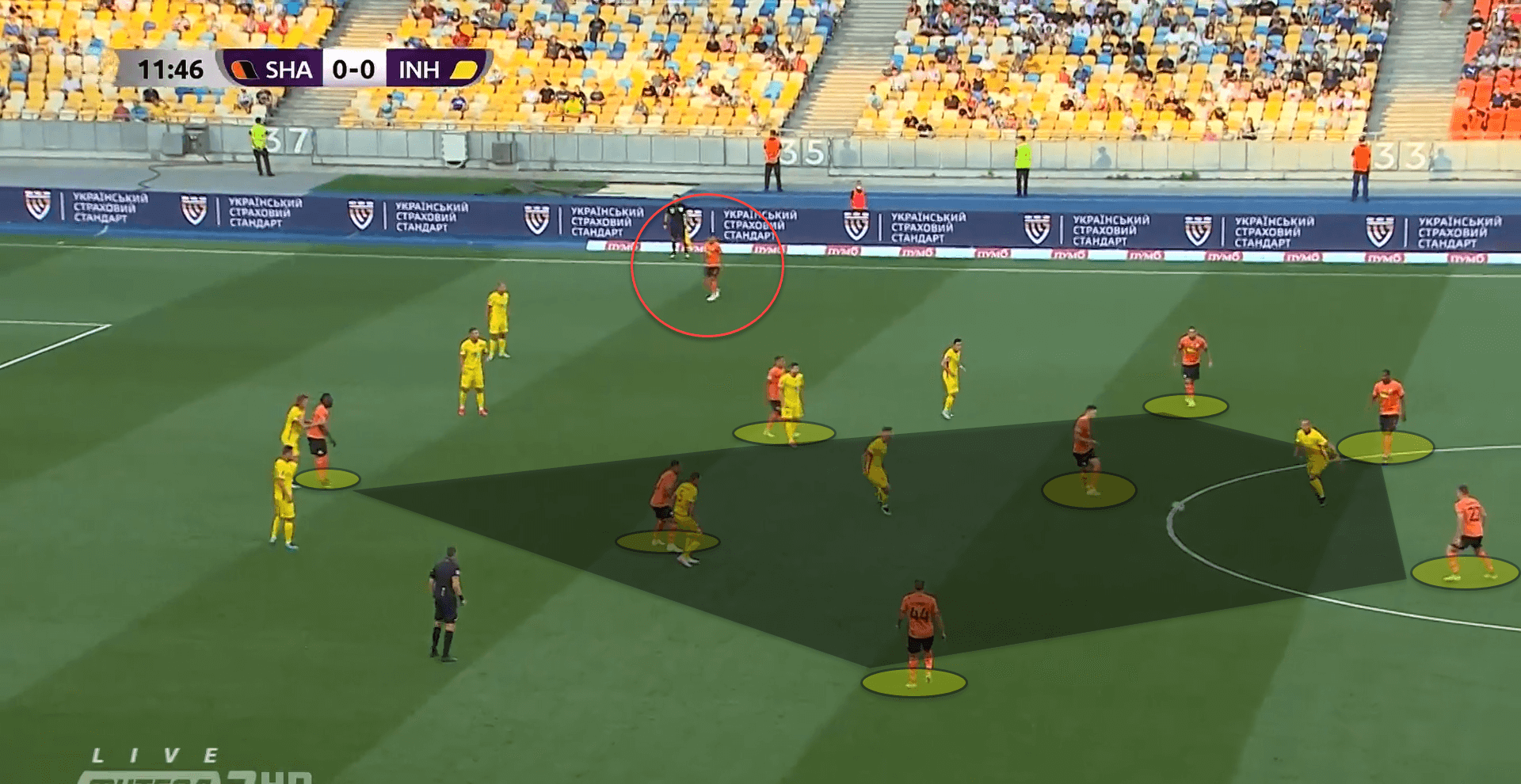
Creating central overloads forces the defensive team to defend with more players in this area in order to ensure that they are not overrun in the middle of the park. However, by the defending side committing more players centrally, they are weakening the wide areas.
This is where Shakhtar take advantage. The centre-backs and midfielders will play short passes to each other in order to retain possession and, when the time is right, they will quickly play out to the flanks to a wide player who is in a 1v1 situation. From there, it is up to the winger or fullback to take on his man and beat him before putting the ball into the box.
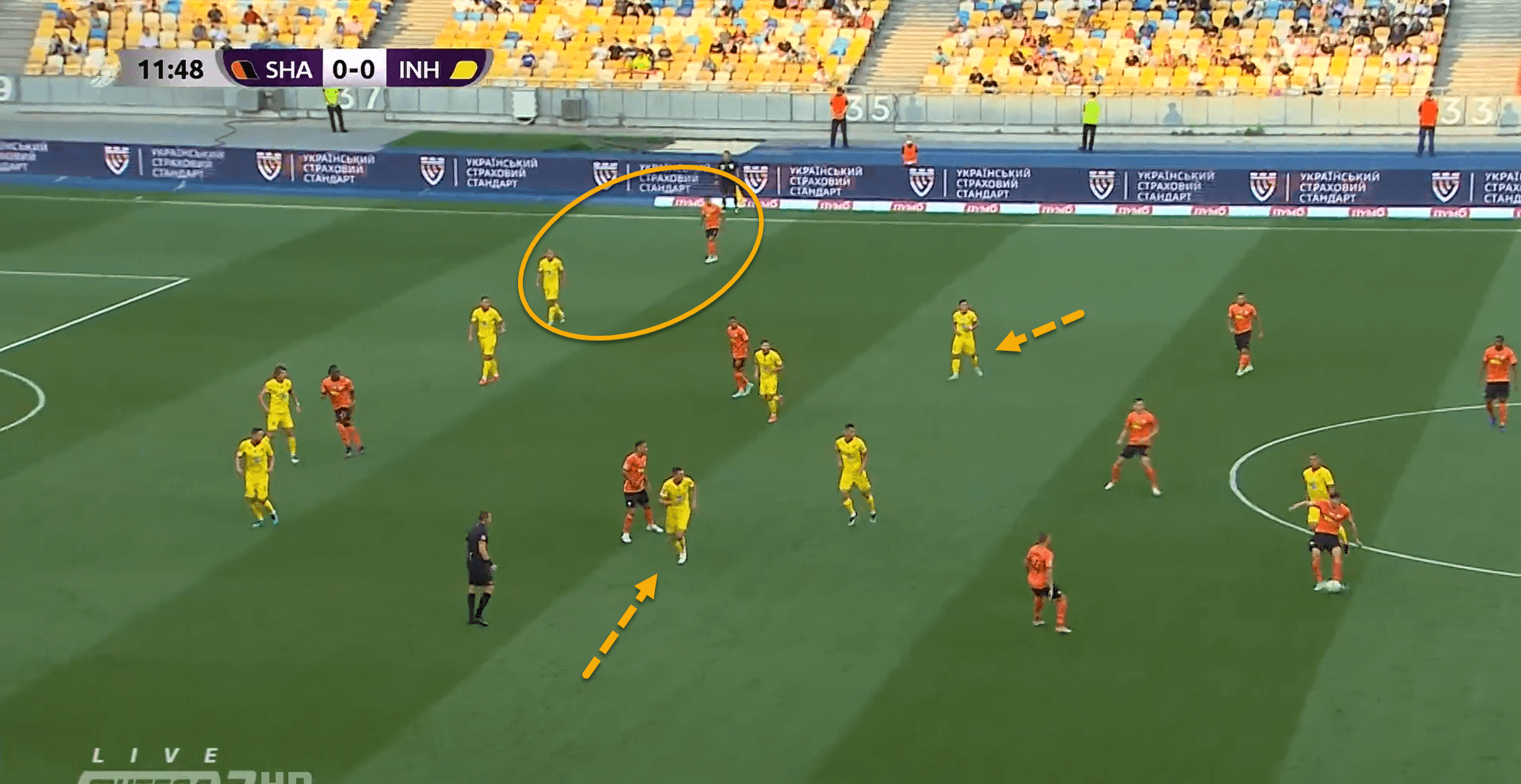
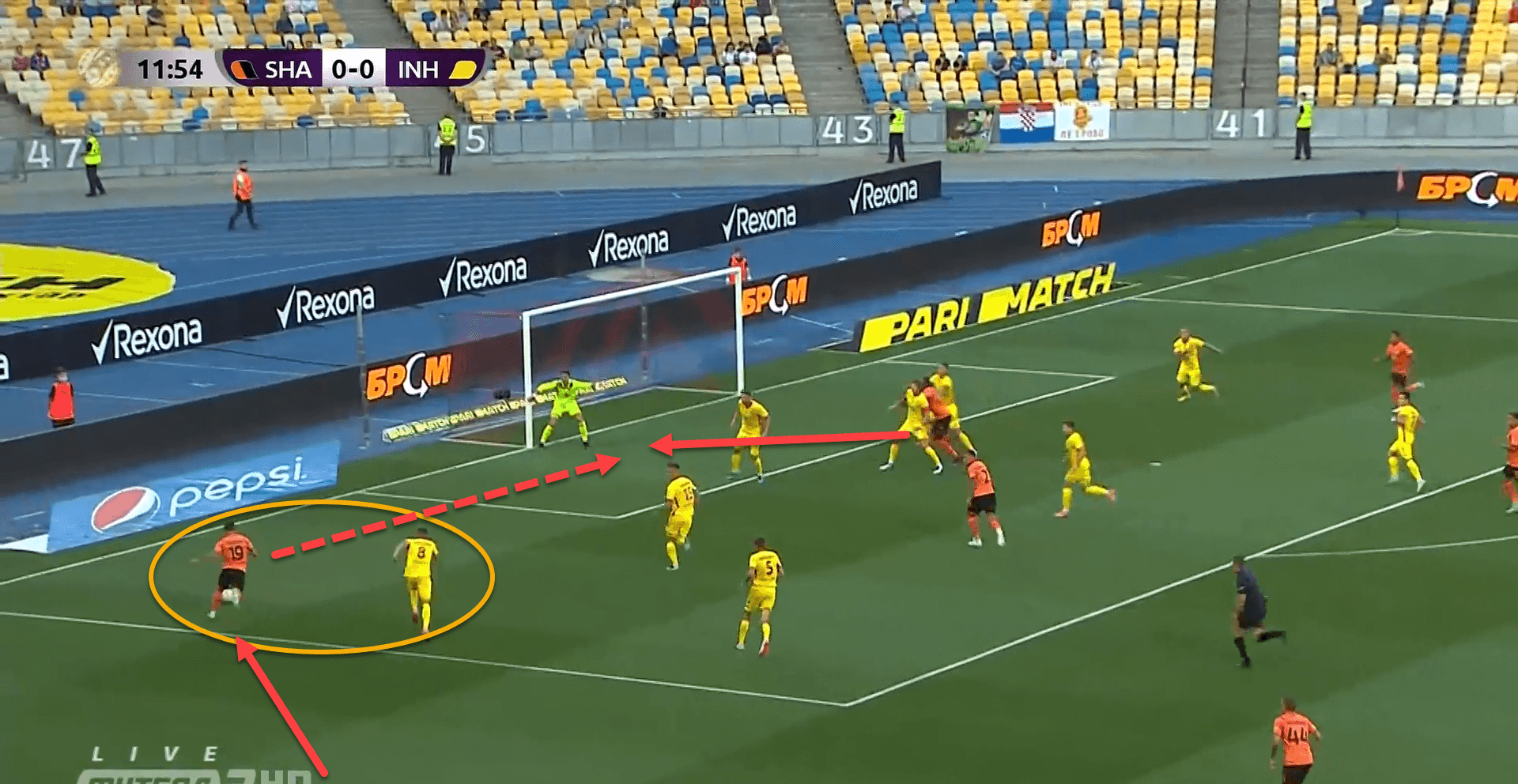
The scenario above depicts exactly how De Zerbi wants his side to play in a positional attack. Shakhtar are sitting in a centrally compact 2-3-2-3 with the left-back inverted while the right-back, Dodo, is pushed ahead on the right.
The opposition are sitting in a 5-4-1 low block and through Shakhtar’s compact positioning, the opposition’s midfield is forced to close together, leaving the wingbacks isolated 1v1 with Shakhtar’s wide players.
The centre-backs and midfielders were playing short passes to each other when a passing lane to the left-winger opened up and so the ball was fired out to the wide-man where the attack picks up steam. The winger, Manor Solomon, successfully dribbled past his man and put a superb ball into the front post for Traore to flick home.
The short passing may seem tedious, cautious, and unnecessary at times but the players on the ball wait for the perfect angle to pass the ball and then the attack speeds up rapidly once they reach the final third.
Attacking variations
Shakhtar like to add variety to their positional attacks when they are in the progression phase in order to prevent their patterns of play from becoming predictable. A lot of positional rotations happen ahead of the ball to stretch the opponent.
One of Shakhtar’s most favoured rotations is to drop a pivot player to the side of the centre-backs whilst the fullback advances forward and the winger pushes inside.
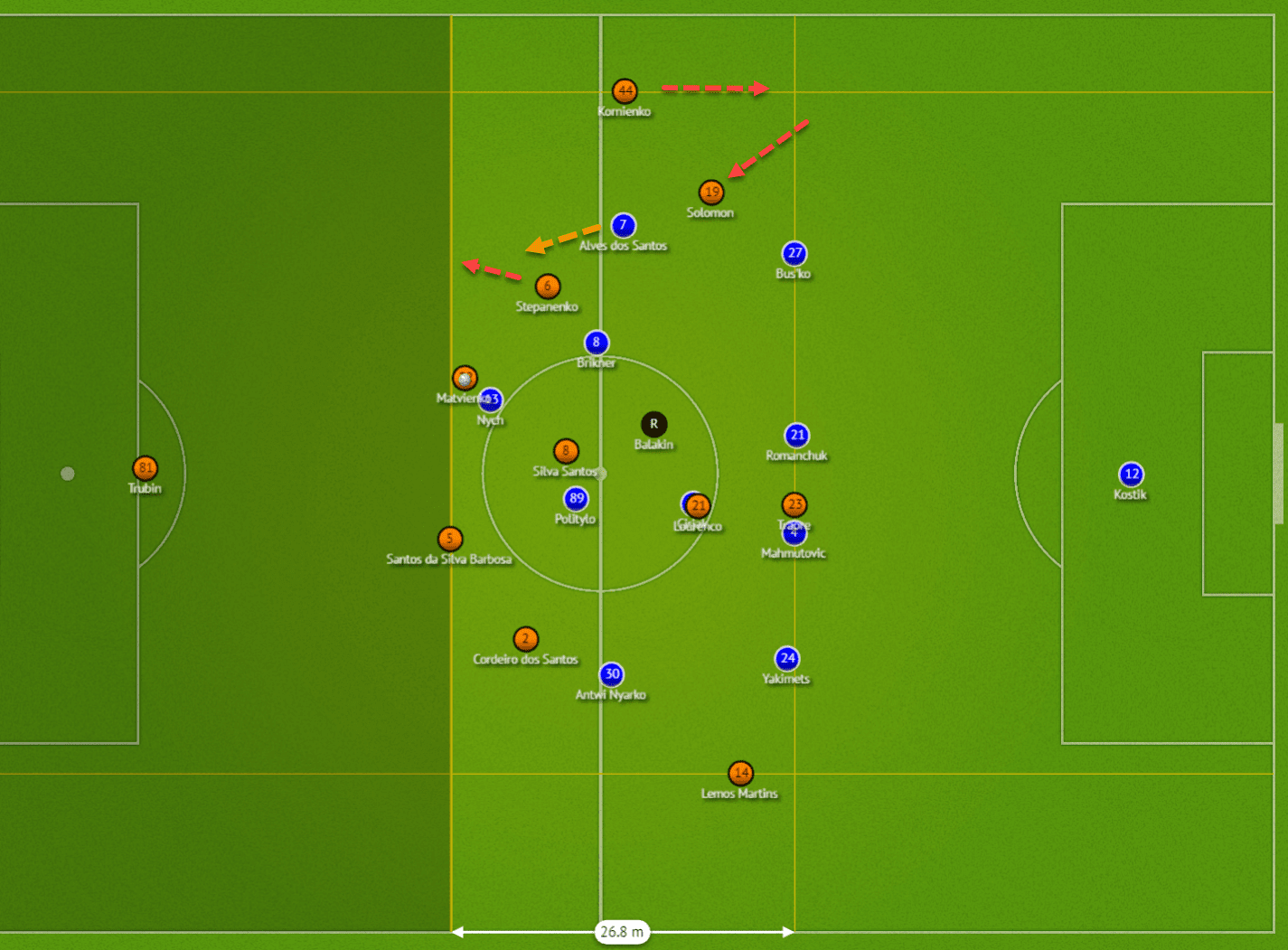
This is a common wide rotation but is still effective, nonetheless. In this situation, Stepanenko has dropped into the first line alongside the left centre-back. This has allowed Korniyenko to get forward on the left flank and for last season’s top scorer, Solomon, to push into the halfspace.
Stepanenko’s movement is very important because he has dragged the opposition’s number 7 away to close him down which in turn has left space for both Solomon and Korniyenko to receive in advanced positions, allowed Shakhtar to break the first line of pressure from their opponent.
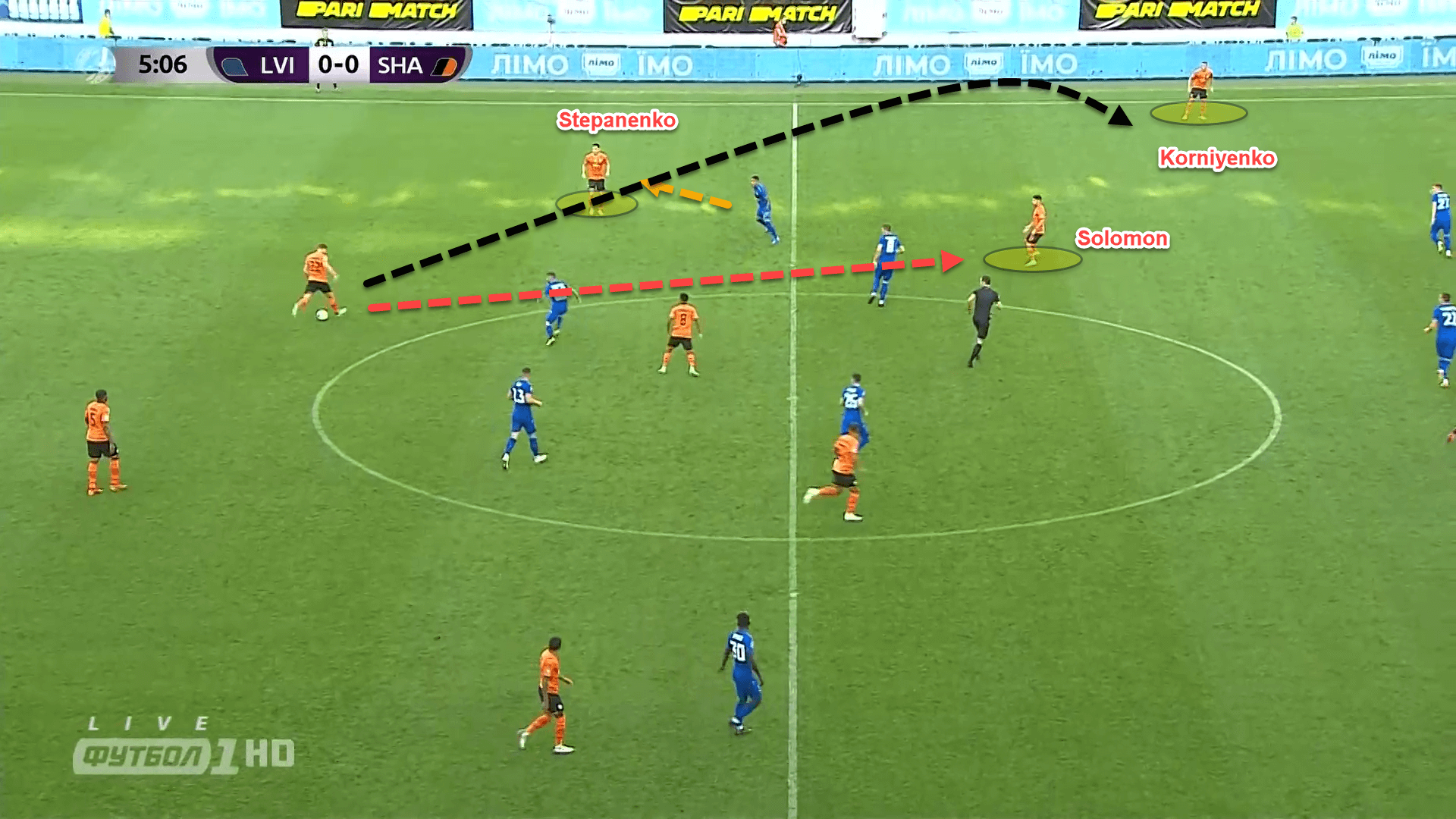
The shape, in this instance, resembles more of a 2-3-2-3 but the formation is not as important to De Zerbi as the space occupied on the field. Sometimes the team’s structure can look more like a Marcelo Bielsa-esque 3-1-3-3 formation.
This structure is predominantly used by the Ukrainian giants against teams that are defending with two players in their first line of pressure, particularly in a 4-4-2.
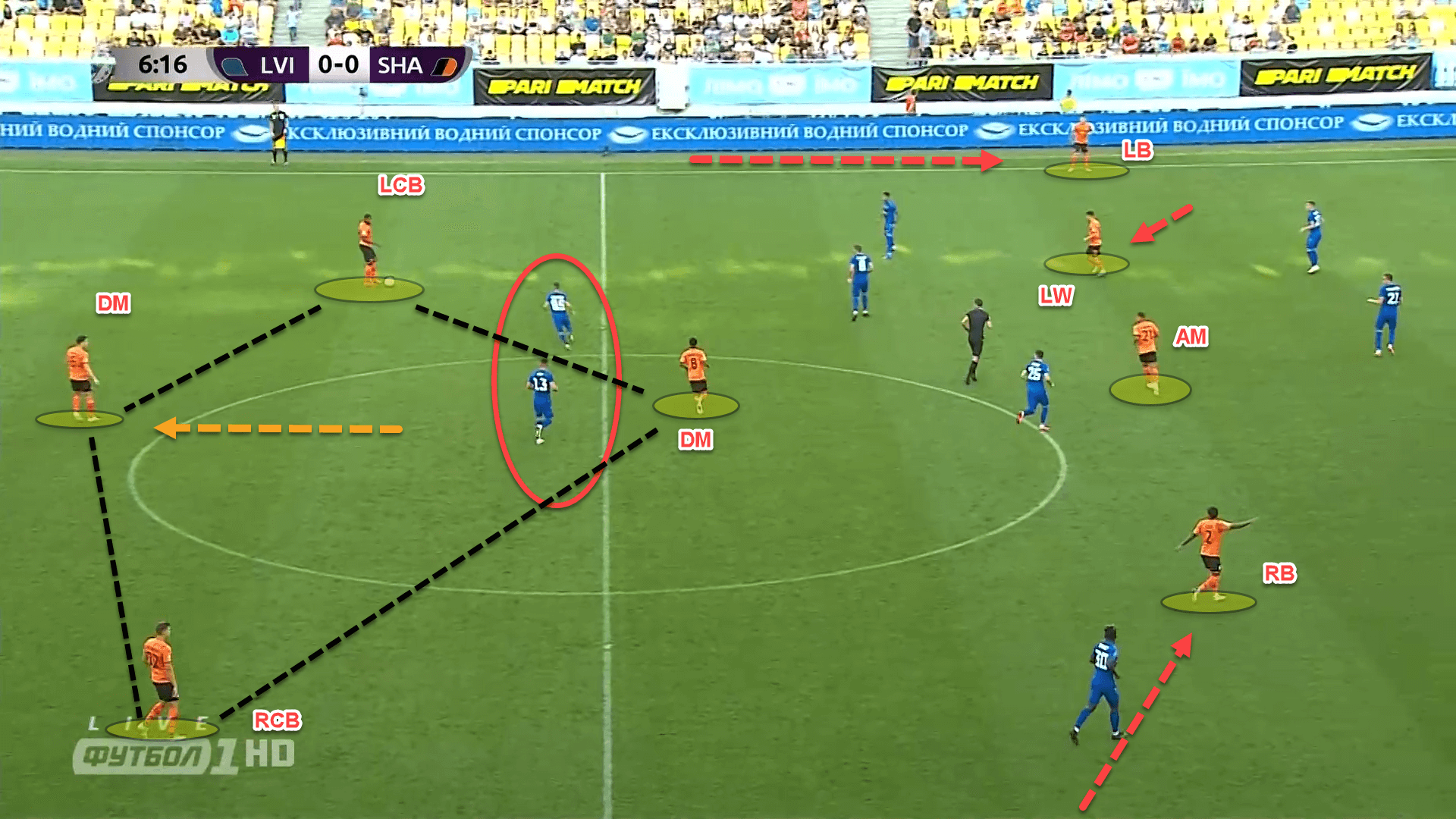
Here, Shakhtar have possession in the progression phase of play against a 4-4-2 mid-to-low level defensive block. The two centre-backs have split wide into the halfspaces to facilitate one of the pivot players dropping into the first line. This creates a 3v2 situation against the opposition’s first line of pressure.
De Zerbi has instructed his men to create a 3-1-3-3 structure, one that facilitates positional rotations. As can be seen in the image above, the Shakhtar right-back has rotated with the right-winger and has pushed up between the lines while the winger is holding the width on the right. On the opposite of the pitch, the left-back is holding the width with the left-winger playing in the halfspace pockets.
Again, this shows that the Italian head coach allows his players to rotate amongst themselves, providing they maintain a good positional structure.
As much as the former Sassuolo head coach wants his side to be able to overload the central areas in order to play out wide, he also likes to try and break through the opposition centrally using intelligent, short passing.
By having a narrow structure and playing short passes in these areas, it forces their opponent’s midfielders and forwards to jump and press from behind, trying to prevent any chance of the ball-carrier turning on the ball and driving forward.
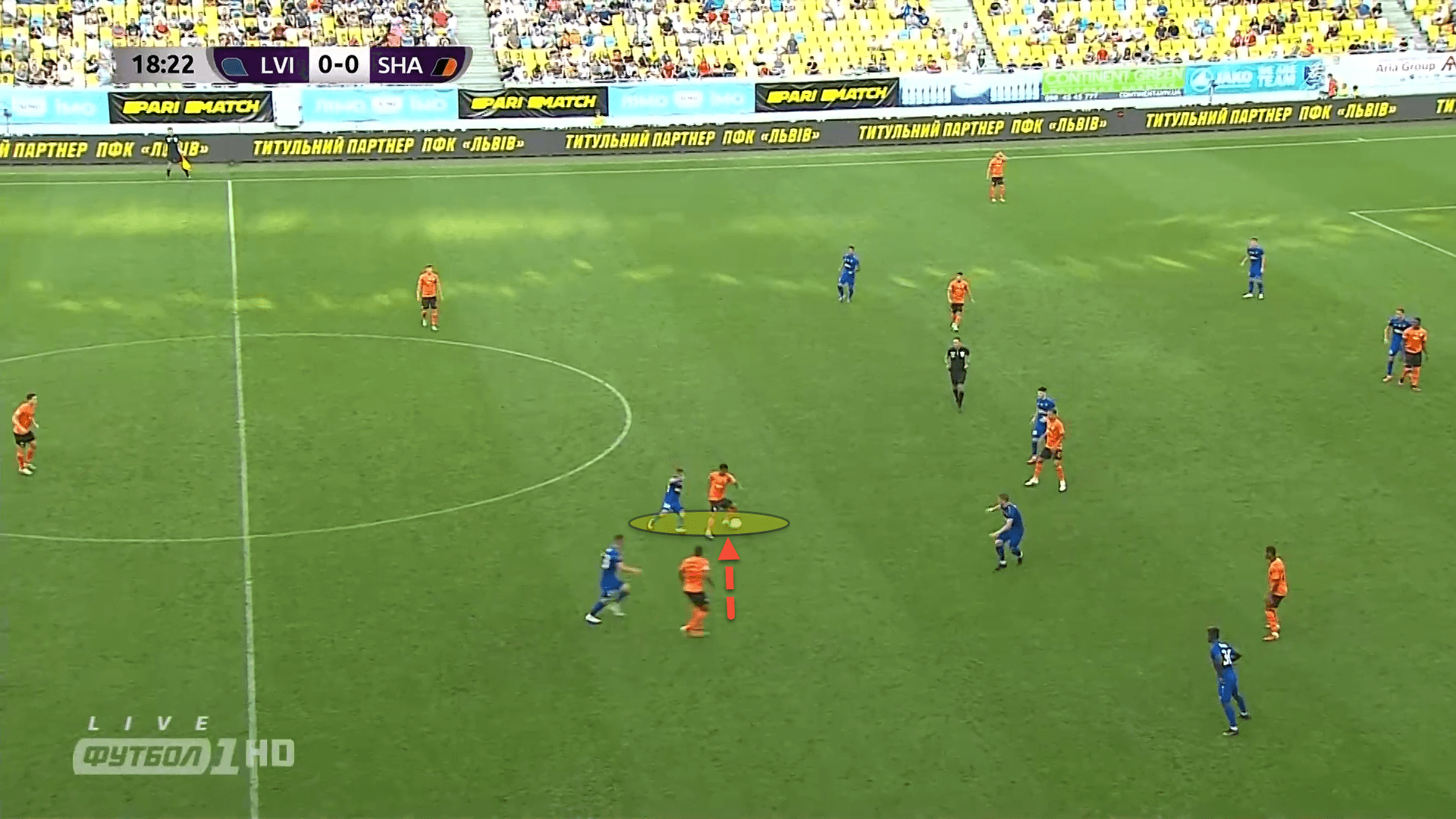
Here is an unsuccessful attempt at jumping Shakhtar’s pivot player. Marcos Antonio received the ball with his back to the FC Lviv centre-forward who quickly jumped to pressure him from behind.
Antonio was able to drop his shoulder and send the forward in the wrong direction while turning on the ball and driving forward. Typically though, in a situation like this, the Shakhtar players will act as a wall pass and bounce the ball back to where it came.
The reason for this is because they know that the defending player will jump them, leaving space on their blindside for a third-man pass.
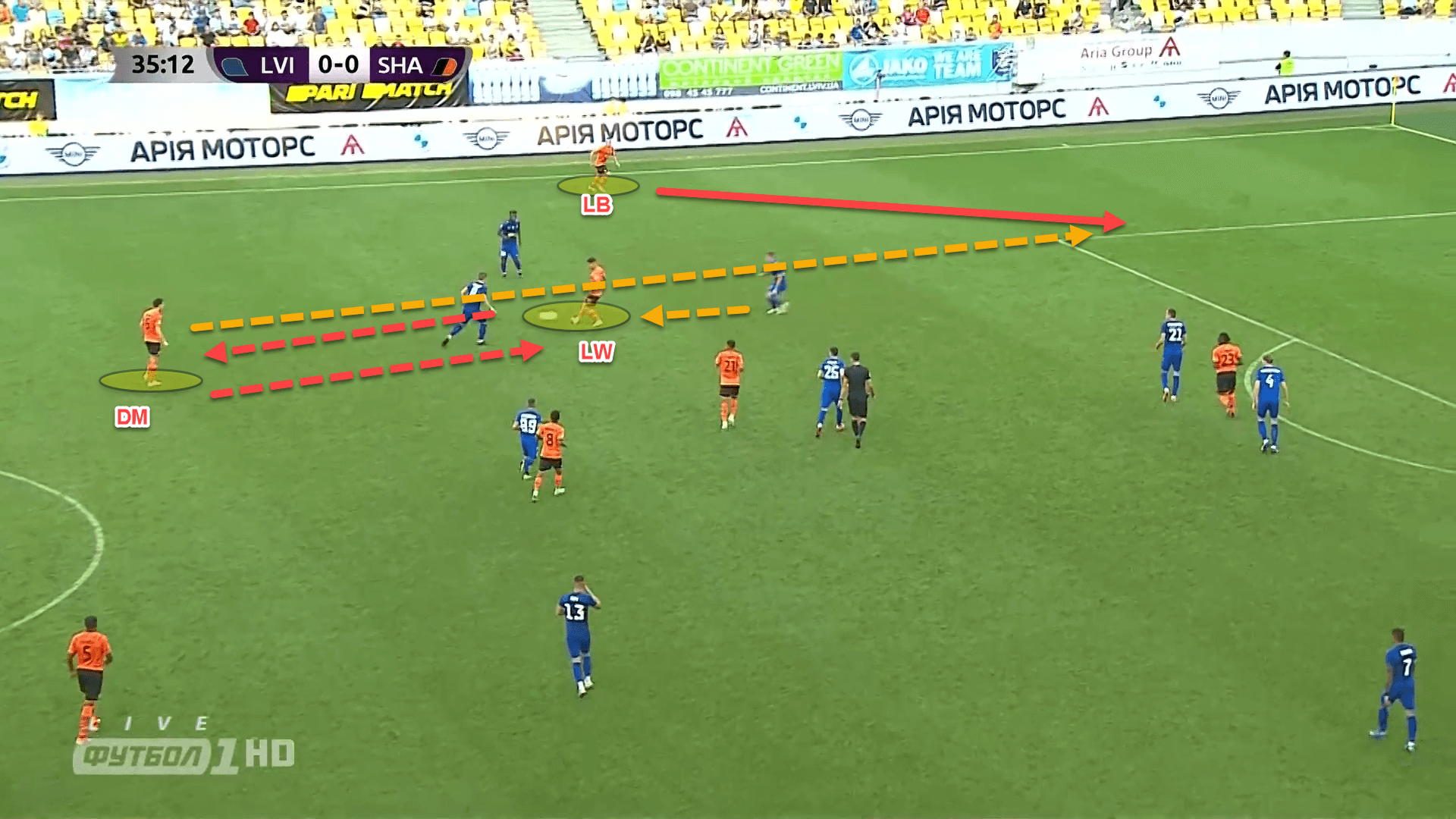
In this image, Shakhtar manage to break through the opposition’s defensive block and reach the penalty area through the halfspace using a simple up-back-through passing move.
The defensive midfielder played a ball into the feet of the left-winger, Solomon, who had positioned himself in the left halfspace pocket. Solomon knew that the Lviv left-back was jumping him from behind and so bounced the ball back to Stepanenko. The Ukraine international spotted a blindside run from Korniyenko and threaded a wonderful through ball into the fullback.
Conclusion
Shakhtar are truly excellent at using different positional variations and passing patterns in order to break down an opponent’s defensive block or to unlock a press. Their positional varieties have made them one of the most entertaining and interesting teams in European football which is a credit to the work that De Zerbi has done since taking over in such a short space of time.






Comments